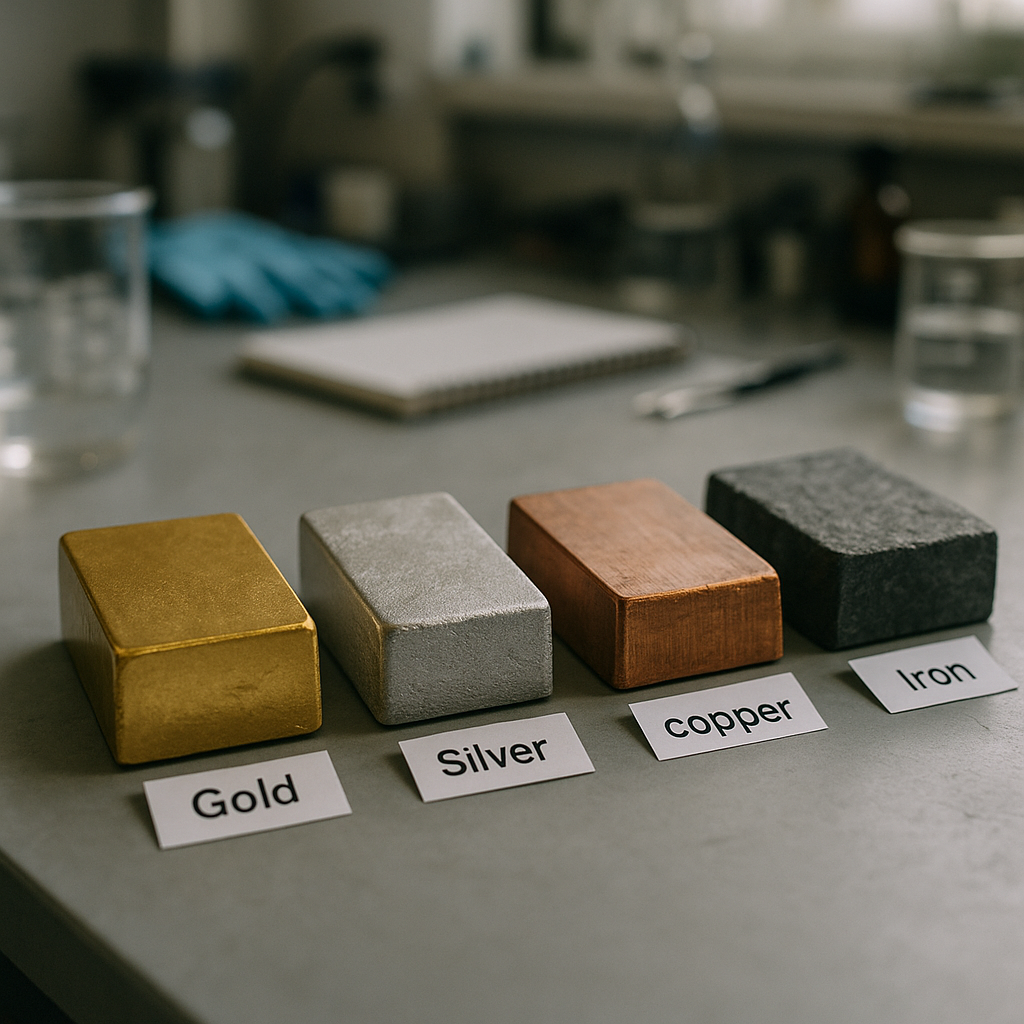5901 Botham Jean Blvd, Dallas, TX 75215
What Is Metal Made Of: Understanding the Basics
June 4, 2025At their core, metals are extraordinary materials composed of the fundamental building blocks of our universe. Every piece of metal, from the copper in electrical wires to the aluminum in recycling bins, consists of atomic materials—specifically electrons, neutrons, and protons.
These microscopic particles, invisible to the naked eye, determine the unique properties of each metal. Electrons play a particularly crucial role in metals. They move freely between atoms, creating what scientists call a “sea of electrons.” This electron mobility makes metals excellent conductors of electricity and heat.
The arrangement of these atomic components forms distinct structures that give metals their characteristic properties—strength, malleability, and conductivity. The specific number and configuration of these particles determine whether the element will be gold, iron, aluminum, or any of the other metallic elements found on the periodic table.
What Are the Common Types of Metals?

The variety of metals is vast, each with unique characteristics suitable for specific uses. Metals are generally categorized by their composition, properties, and applications in industries such as recycling.
Ferrous vs. Non-Ferrous Metals
A primary distinction in metal classification is the presence of iron. This separation is crucial in recycling, influencing sorting processes and end markets.
Ferrous metals contain iron and are usually magnetic. These include steel, cast iron, and wrought iron, offering strong structural support but often requiring treatment to resist corrosion.
Non-ferrous metals have little or no iron. This group includes aluminum, copper, lead, zinc, gold, silver, and titanium. These metals are generally more corrosion-resistant but can be more costly than ferrous metals.
Common Pure Metals
Pure metals consist of a single element. Notable examples include:
Aluminum is notable for being lightweight and corrosion-resistant. As the most abundant metal in Earth’s crust, it is essential in packaging, transportation, and construction.
Copper is known for its excellent electrical and thermal conductivity. This reddish-brown metal has been used for over 10,000 years and remains crucial for electrical wiring, plumbing, and electronics.
Iron is fundamental to steel production. Despite its tendency to rust, its abundance and strength make it indispensable in manufacturing and construction.
Metal Alloys
Alloys are combinations of two or more metals, enhancing their properties. Common alloys include:
Steel, made by combining iron with carbon and sometimes other elements, is versatile, used in everything from building frameworks to kitchen utensils. Stainless steel, which includes chromium, offers enhanced corrosion resistance.
Brass, an alloy of copper and zinc, is appreciated for its gold-like appearance, workability, and corrosion resistance, making it popular in decorative items, musical instruments, and plumbing fixtures.
Bronze, traditionally a mix of copper and tin, was one of the first alloys created. Modern bronze may include elements like aluminum or silicon to enhance certain properties.
Precious and Specialty Metals
Some metals are valued for their rarity, appearance, or special properties:
Gold and silver have been treasured for ages for their beauty, rarity, and corrosion resistance. Beyond jewelry and currency, they play significant roles in electronics and medical applications.
Titanium offers a remarkable strength-to-weight ratio and biocompatibility. Its higher cost is justified in aerospace, medical implants, and high-performance applications.
Tungsten has the highest melting point of all metals at 3,422°C. Its hardness and heat resistance make it crucial for applications involving extreme temperatures, such as filaments and cutting tools.
Classification by Properties
Metals can also be categorized by their physical and chemical characteristics:
Density distinguishes heavy metals like lead and mercury from light metals such as aluminum and magnesium, a key factor in transportation where weight is critical.
Refractory metals like tungsten, molybdenum, and tantalum resist heat and wear, maintaining strength at high temperatures, making them valuable in demanding industrial settings.
Recyclability varies significantly among metals. While aluminum and steel have established recycling streams, specialty and precious metals often require more advanced recovery methods.
How Are Metals Produced?
Metal production, particularly steel, involves a carefully orchestrated sequence of steps that transform raw materials into usable metal products. The journey from earth to finished steel follows a logical progression refined over centuries of metallurgical innovation.
The process begins with coking coal, a critical component in traditional steel production. Coking coal is heated to approximately 1800°F without oxygen, removing volatile elements like oil, tar, and sulfur. The resulting coke is a concentrated carbon material that provides both heat and the chemical reducing agents needed in the next phase.
Iron making is the second major step. In a blast furnace, iron ore, limestone, and coke are combined. The furnace creates extreme temperatures that melt the iron ore. During this process, the carbon from the coke pulls oxygen away from the iron oxide in the ore, producing molten iron along with slag, a byproduct containing impurities.
The resulting molten iron contains about 4% carbon content, which is too high for steel production. This leads to the third phase: steel making. In a basic oxygen furnace, pure oxygen is blown through the molten iron, oxidizing the excess carbon and removing it as carbon dioxide gas. Alternatively, in electric arc furnaces, electricity provides the intense heat needed to melt scrap steel, which can then be refined into new steel products.
Throughout this complex process, precise control of temperature and chemistry transforms raw earth materials into metal that can be cast into slabs, sheets, or other forms. Modern steel plants often automate these steps to ensure consistent quality and efficient production of the exact steel grade needed for specific applications.
The evolution of steel production techniques has significantly improved efficiency over time. What once required days of labor-intensive work can now be completed in under an hour in modern facilities. These advances have made steel one of the most widely used materials in our world, with applications ranging from construction to automotive manufacturing.
What Are the Key Characteristics of Metals?

Metals exhibit unique properties that set them apart from other materials in the recycling stream. These characteristics make them highly valuable in the circular economy and explain their widespread use across various industries.
Conductivity
Metals excel in transferring electricity and heat. Their high electrical conductivity allows them to efficiently carry electric current, making them essential in power transmission lines, electronic devices, and electrical components.
Thermal conductivity is equally important. Metals transfer heat rapidly and evenly, which is why copper pots and pans heat uniformly. Heat sinks in electronics rely on metal’s thermal conductivity to dissipate excess heat from sensitive components.
Malleability
Malleability is the ability to be hammered or rolled into thin sheets without breaking. This property arises from the unique metallic bond structure where metal cations exist within a “sea” of delocalized electrons. When force is applied, these bonds can rearrange without breaking.
Malleability allows metals to be formed into flat sheets for roofing materials, food packaging, and automotive bodies. Gold can be hammered into sheets just a few atoms thick. Aluminum’s malleability makes it ideal for foil and beverage cans.
Ductility
Ductility refers to a metal’s ability to be drawn into wires without breaking, also due to the flexible metallic bonding structure. Copper wiring in homes demonstrates this property well.
Ductile metals can stretch significantly before breaking, making them crucial in construction where tensile strength matters. Steel cables in suspension bridges rely on this property to support massive loads while maintaining their integrity.
Luster
The characteristic shine or reflective quality of metals is called luster, occurring because metals reflect most light striking their surface. When polished, this property becomes even more pronounced.
Metal’s lustrous appearance makes it valuable in decorative applications. Jewelry, silverware, and architectural elements showcase this property. Even in industrial settings, the distinctive shine helps identify metal components.
Additional Properties
Beyond these main characteristics, metals possess other notable traits. Their sonority allows them to vibrate and produce sound when struck, explaining their use in musical instruments and bells.
Metals typically have high melting points, making them suitable for high-temperature applications. Steel’s resistance to heat allows its use in furnaces and engines.
Most metals display impressive tensile strength, varying by metal type. Structural steel can withstand enormous stress before failing, while lead deforms relatively easily.
Thermal expansion, the tendency to change size with temperature, affects how metals perform in various applications. Engineers must account for this property when designing bridges, railroad tracks, and precision machinery.
| Metal | Color | Properties | Typical Use | Value |
|---|---|---|---|---|
| Aluminum | Silvery white | Non-magnetic, excellent conductor of electricity, corrosion resistant | Drink cans, window frames, cooking pots | $$$ |
| Brass | Yellowish | Hard, corrosion resistant, malleable, ductile | Lamp fittings, electrical terminals, locks | $$ |
| Copper | Reddish brown | Malleable, ductile, excellent conductor of heat and electricity | Wires, motors, plumbing | $$$$ |
| Gold | Yellow | Soft, ductile, malleable, resistant to tarnish | Jewelry, coinage, electronics | $$$$$$ |
| Lead | Dull silvery-grey | Dense, durable, malleable, corrosion-resistant | Pipes, ammunition, radiation protection | $$$ |
| Silver | Shiny grey | Lustrous, soft, ductile, highest thermal and electrical conductor | Jewelry, silverware, electrical contacts | $$$$$ |
| Steel | Dark grey or metallic shiny grey | Magnetic, durable, ductile, tough | Bars, rods, automotive parts | $ |
Conclusion: The Importance of Understanding Metal Composition

Understanding metal composition is essential for advancing engineering and material science. The atomic structure of metals influences their conductivity, strength, malleability, and corrosion resistance. These properties determine metal performance in various applications across industries. Knowledge of crystal structures—body-centered cubic, face-centered cubic, or hexagonal close-packed—provides crucial insights into metal behavior under different conditions.
Metals are fundamental to modern infrastructure, from construction materials to electronic components. Their thermal and electrical conductivity makes them indispensable in technologies we use daily. The relationship between processing techniques and resulting properties allows engineers to create custom materials for specific needs. This understanding fosters innovation in fields like aerospace and automotive manufacturing, where safety and performance are crucial. For proper metal recycling and sustainable material management, contact Okon Recycling at 214-717-4083.
